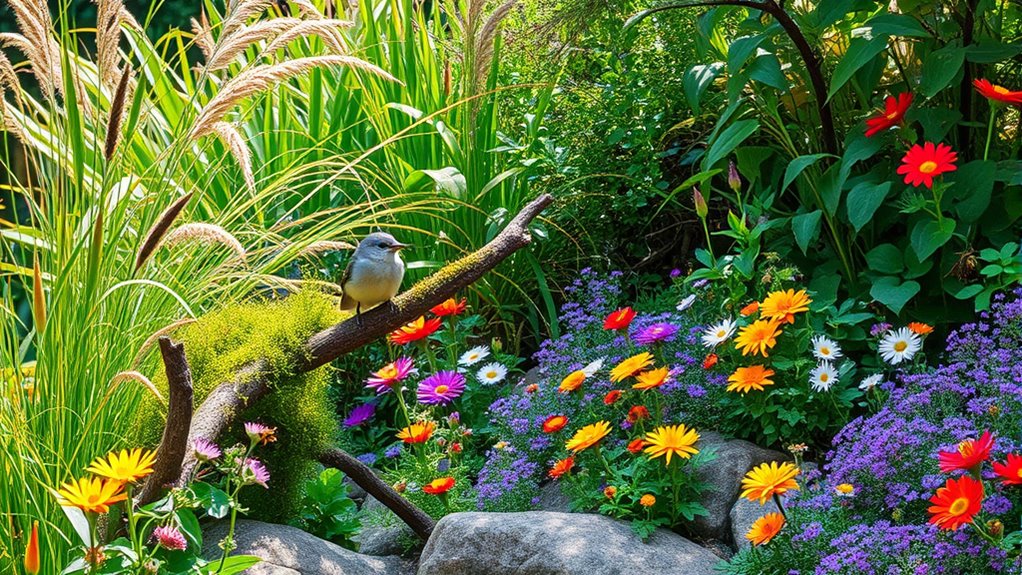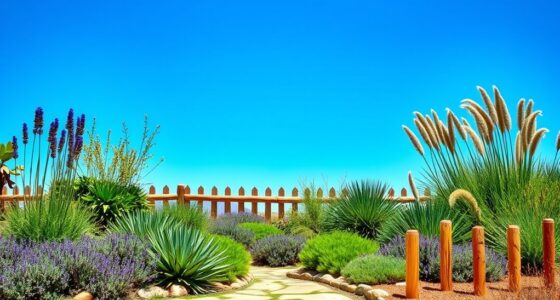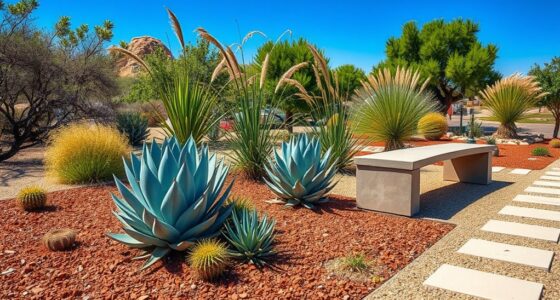Redefining garden perfection for wildlife support involves blending native plants with natural water features to create a balanced habitat. By choosing plants suited to your local climate, you’ll need less maintenance and attract pollinators year-round. Incorporate shallow, naturalistic water sources to provide drinking and bathing spots for birds, butterflies, and bees. Creating this layered environment encourages diverse wildlife, enriching your garden’s beauty and ecological health. Keep exploring how small changes can turn your garden into a thriving refuge.
Key Takeaways
- Incorporate native plants to provide essential food sources and habitat for local wildlife.
- Design naturalistic water features that offer drinking, bathing, and breeding sites.
- Create layered habitats combining plants and water to support diverse species year-round.
- Use natural elements like rocks and plants around water features to enhance shelter and resting spots.
- Prioritize sustainable, low-maintenance designs that promote ecological health and biodiversity.

Have you ever wondered how to transform your garden into a haven for local wildlife? Creating a space that supports birds, bees, butterflies, and other creatures doesn’t mean sacrificing beauty or convenience. Instead, it involves thoughtful choices that make your garden a vibrant, sustainable environment. One of the most effective ways to do this is by incorporating native plantings. Native plants are perfectly suited to your region’s soil, climate, and pests, making them easier to care for while providing essential food and shelter for local wildlife. When you select native species, you’re creating a natural habitat that encourages animals to visit and stay, helping to restore the balance of local ecosystems. These plants often flower at different times of the year, offering a continuous source of nectar, pollen, and seeds. Plus, they typically require less water, fertilizer, and pesticides, making your garden more environmentally friendly and easier to maintain.
AI-driven insights from industry trends can help you choose the most beneficial native plants tailored to your local environment.
Pairing native plantings with water features elevates your garden’s appeal for wildlife even further. Water is a critical resource, especially during dry spells, and a pond, birdbath, or small fountain can become a magnet for many species. Birds use water features for drinking and bathing, while butterflies and bees are drawn to the moisture and minerals they offer. When designing your water feature, consider naturalistic shapes and shallow edges that provide easy access for small creatures. Incorporate rocks or plants around the edges to create hiding spots and resting places. Keep the water clean and fresh, changing it regularly or installing a gentle pump to prevent stagnation. This not only attracts more wildlife but also helps prevent mosquito breeding.
The combination of native plantings and water features creates a layered habitat, offering food, shelter, and water in close proximity. This setup encourages a diverse array of species to thrive in your garden, turning it into a lively, vibrant ecosystem. As you plan these elements, think about how each piece interacts with the others and how they can work together to support local wildlife year-round. Small changes can make a big difference; even adding a few native plants or a simple birdbath can considerably boost the appeal of your garden for creatures seeking refuge and sustenance. By prioritizing these natural elements, you’re not just creating a beautiful garden—you’re fostering a crucial refuge that benefits both wildlife and your own enjoyment of nature’s beauty.
Frequently Asked Questions
How Can I Attract Specific Native Species to My Garden?
To attract specific native species, you should focus on native plant selection that appeals to those animals. Plant a variety of species to increase habitat diversity, offering food, shelter, and breeding sites. Research the preferences of your target species and include their favorite plants. Avoid pesticides and chemicals, and provide water sources. By creating a welcoming, diverse environment, you’ll encourage your desired native wildlife to visit and thrive in your garden.
What Are Eco-Friendly Methods for Controlling Pests?
You can control pests eco-friendly by using companion planting, which naturally repels unwanted insects and attracts beneficial ones. Incorporate natural repellents like neem oil or garlic spray to deter pests without harmful chemicals. Regularly check your plants for early signs of trouble, and encourage biodiversity by planting a variety of native species. These methods support your garden’s health while protecting wildlife and reducing environmental impact.
How Do I Ensure Year-Round Wildlife Support?
Imagine your garden as a bustling wildlife refuge, alive all year. To achieve this, you should embrace seasonal plant selection, planting blooms and berries that flourish in every season. Mix habitat diversity by including native trees, shrubs, and flowers, creating a mosaic of shelter and food sources. With these strategies, your garden becomes a sanctuary that continually beckons birds, butterflies, and beneficial insects, ensuring year-round wildlife support.
Can Urban Gardens Effectively Support Local Ecosystems?
Yes, urban gardens can effectively support local ecosystems through thoughtful garden design and urban planning. By incorporating native plants, creating diverse habitats, and providing water sources, you attract pollinators and birds. Properly planning your space guarantees year-round support, benefiting wildlife even in small areas. Your efforts can make a significant difference by blending ecological needs with urban aesthetics, fostering a healthier environment for local species.
What Plants Are Best for Supporting Pollinators Year-Round?
You should plant native bee plants and hummingbird favorites to support pollinators year-round. Native bee plants attract essential pollinators and provide consistent nectar, while hummingbird favorites like trumpet creeper and bee balm keep hummingbirds fed throughout the seasons. By choosing a variety of these plants that bloom at different times, you create a continuous food source, ensuring pollinators thrive and your garden remains vibrant year-round.
Conclusion
By embracing diverse plants, providing cozy habitats, and planting with purpose, you create a haven that welcomes wildlife. You nurture birds, bees, and butterflies, supporting their survival and thriving. You foster a space that’s vibrant, lively, and full of life. You turn your garden into a sanctuary, a refuge, a paradise for nature. And in doing so, you not only support wildlife—you transform your garden into a true masterpiece of harmony and beauty.









